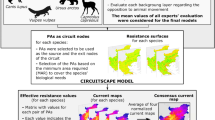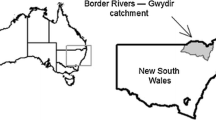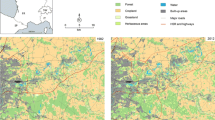Abstract
Context
Linear anthropogenic barriers may reduce structural landscape connectivity for wildlife.
Objectives
Using graph-based connectivity indices, we modeled the potential impacts of linear barriers on structural connectivity and on individual patch importance at different biologically justified dispersal distance thresholds for the Sonoran desert tortoise, a wide-ranging species for which anthropogenic barriers may be reducing structural landscape connectivity.
Methods
To characterize the potential impacts of barriers on structural connectivity for the Sonoran desert tortoise, we compared network compartmentalization, individual habitat patch importance, and the spatial distribution of important habitat patches for models of structural connectivity reflecting the landscape prior to the development of linear barriers to models depicting current linear barriers in the landscape at different distance thresholds.
Results
Linear barriers fragmented the habitat patch network into a minimum of 239 patch components. Compartmentalization increased little as dispersal distance thresholds exceeded 10 km. In barrier simulations, patch importance mostly decreased and the spatial distribution of important patches shifted south.
Conclusion
Barriers are limiting structural connectivity for Sonoran desert tortoises and may prevent dispersal events, rescue effects in the event of localized extinctions, and successful range shift in response to climate change. Management efforts targeted at enhancing connectivity for ecological processes or movements occurring at 5–10 km may enhance the potential for longer-distance movements or generational dispersal occurring at a greater extent. Our methods provide an efficient framework for assessing changes in structural connectivity on a landscape extent that may be applied to addressing different problems or questions related to landscape connectivity.








Similar content being viewed by others
Data availability
All data produced as part of this study are property of the U.S. Department of the Interior National Park Service Southwest Border Resource Protection Program. Code and example data for reproducing these analyses will be made available upon request to the corresponding author.
References
AIDTT (Arizona Interagency Desert Tortoise Team) (2000) Status of the Sonoran population of the desert tortoise in Arizona: an update. In: Averill-Murray RC (ed) Sonoran desert tortoise ecology and conservation. Arizona Game and Fish Department, Phoenix
Andrews KM, Langen TA, Struijk RP (2015) Reptiles: overlooked but often at risk from roads. In: van der Ree R, Smith DJ, Grilo C (eds) Handbook of road ecology, 1st edn. Wiley, West Sussex, pp 271–280
Averill-Murray RC, Averill-Murray A (2005) Regional-scale estimation of density and habitat use of the desert tortoise (Gopherus agassizii) in Arizona. J Herpetol 39:65–72
Averill-Murray RC, Klug CM (2000) Monitoring and ecology of Sonoran desert tortoises in Arizona. Nongame and endangered wildlife program technical report 161. Arizona Game and Fish Department, Phoenix
Averill-Murray RC, Fleming CH, Riedle J (2020) Reptile home ranges revisited: a case study of space use of Sonoran desert tortoises (Gopherus morafkai). Herpetol Conserv Biol 15:253–271
Beier P (2019) A rule of thumb for widths of conservation corridors. Conserv Biol 33:976–978
Beyer HL, Gurarie E, Börger L, Panzacchi M, Basille M, Herfindal I, Van Moorter B, Lele S, Matthiopoulos J (2016) ‘You shall not pass!’: quantifying barrier permeability and proximity avoidance by animals. J Anim Ecol: 85:43–53. https://doi.org/10.1007/s10980-022-01566-x
Boarman WI, Sazaki M, Jennings WB (1997) The effect of roads, barrier fences, and culverts on desert tortoise populations in California, USA. Proceedings: conservation, restoration, and management of tortoises and turtles-an international conference. New York Turtle and Tortoise Society, New York, pp 54–58
Bodin Ö, Norberg J (2007) A network approach for analyzing spatially structured populations in fragmented landscapes. Landsc Ecol 1:31–44
Bunn AG, Urban DL, Keitt TH (2000) Landscape connectivity: a conservation application of graph theory. J Environ Manag 59:265–278
Burgess TL, Braun J, Witte CL, Lamberski N, Field KJ, Allison LJ, Averill-Murray RC, Drake K, Nussear KE, Esque TC, Rideout BA (2021) Assessment of disease risk associated with potential removal of anthropogenic barriers to Mojave desert tortoise (Gopherus agassizii) population connectivity. J Wildl Dis 57:579–589
Calabrese JM, Fagan WF (2004) A comparison-shopper’s guide to connectivity metrics. Front Ecol Environ 2:529–536
Campbell C, Kennedy K (2010) The Sonoran desert conservation plan and regional transportation authority: citizen support for habitat connectivity and highway mitigation. In: Beckmann JP, Clevenger AP, Huijser M, Hilty JA (eds) Safe passages: highways, wildlife and habitat connectivity, 1st edn. Island Press, Washington, pp 277–308
Carter SK, Nussear KE, Esque TC, Leinwand IIF, Masters E, Inman RD, Carr NB, Allison LJ (2020) Quantifying development to inform management of Mojave and Sonoran desert tortoise habitat in the American southwest. Endanger Species Res 42:167–184
Drake JC, Griffis-Kyle KL, McIntyre NE (2017) Graph theory as an invasive species management tool: case study in the Sonoran desert. Landsc Ecol 32:1739–1752
Dutcher KE, Vandergast AG, Esque TC, Mitelberg A, Matocq MD, Heaton JS, Nussear KE (2020) Genes in space: what Mojave desert tortoise genetics can tell us about landscape connectivity. Conserv Genet 21:289–303
Edwards T, Schwalbe CR, Swann DE, Goldberg CS (2004) Implications of anthropogenic landscape change on inter-population movements of the desert tortoise (Gopherus agassizii). Conserv Genet 5:485–499
Fahrig L, Rytwinski T (2009) Effects of roads on animal abundance: an empirical review and synthesis. Ecol Soc 14:21. https://www.ecologyandsociety.org/vol14/iss1/art21/
Fahrig L, Arroyo-Rodríguez V, Cazetta E, Ford A, Lancaster J, Ranius T (2021) Landscape connectivity. In: Perry G, Francis R, Millington J, Minor E (eds) The Routledge handbook of landscape ecology. Taylor and Francis, Milton Park, pp 67–88
Flesch AD, Epps CW, Cain JW III, Clark M, Krausman PR, Morgart JR (2010) Potential effects of the United States-Mexico border fence on wildlife. Conserv Biol 24:171–181
Frankel OH, Franke O, Soulé ME (1981) Conservation and evolution. Cambridge University Press, Cambridge
Gammage G, Hall JS, Lang R, Welch N, Melnick R (2008) Megapolitan, Arizona’s sun corridor. Morrison Institute for Public Policy, Arizona State University, Phoenix
Griffis-Kyle KL, Mougey K, Vanlandeghem M, Swain S, Drake JC (2018) Comparison of climate vulnerability among desert herpetofauna. Biol Conserv 225:164–175
Gurrutxaga M, Saura S (2014) Prioritizing highway defragmentation locations for restoring landscape connectivity. Environ Conserv 41:157–164. https://doi.org/10.1017/S0376892913000325
Guyer C, Hermann SM, Johnson VM (2014) Social behaviors of North American tortoises. In: Rostal DC, McCoy ED, Mushinsky HR (eds) Biology and conservation of North American Tortoises. JHU press, pp 102–109
Hajost SA (1984) US–Mexico environmental cooperation: agreement between the United States of America and the United Mexican States on cooperation for the protection and improvement of the border area. Environ Law 1984:1–3
Heller NE, Zavaleta ES (2009) Biodiversity management in the face of climate change: a review of 22 years of recommendations. Biol Conserv 142:14–32
Howland JM, Rorabaugh JC (2002) Conservation and protection of the desert tortoise in Arizona. In: Van Devender TR (ed) The Sonoran desert tortoise: natural history, biology, and conservation. The University of Arizona Press and the Arizona-Sonora Desert Museum, Tucson, pp 334–354
Hromada SJ, Esque TC, Vandergast AG, Dutcher KE, Mitchell CI, Gray ME, Chang T, Dickson BG, Nussear KE (2020) Using movement to inform conservation corridor design for Mojave desert tortoise. Mov Ecol 8:1–18
Keitt TH, Urban DL, Milne BT (1997) Detecting critical scales in fragmented landscapes. Conserv Ecol 1:4
King AW, With KA (2002) Dispersal success on spatially structured landscapes: when do spatial pattern and dispersal behavior really matter? Ecol Model 147:23–39
Lande R (1988) Genetics and demography in biological conservation. Science 241:1455–1460
Landguth EL, Cushman SA, Schwartz MK, McKelvey KS, Murphy M, Luikart G (2010) Quantifying the lag time to detect barriers in landscape genetics. Molec Ecol 19:4179–4191
Lasky JR, Jetz W, Keitt TH (2011) Conservation biogeography of the US–Mexico border: a transcontinental risk assessment of barriers to animal dispersal. Divers Distrib 17:673–687
Latch EK, Boarman WI , Walde A, Fleischer RC (2011) Finescale analysis reveals cryptic landscape genetic structure in desert tortoises. PLoS One 6(11): e27794. https://doi.org/10.1371/journal.pone.0027794
MacArthur RH, Wilson EO (1967) The theory of island biogeography, vol 1. Princeton University Press, Princeton
McRae BH, Hall SA, Beier P, Theobald TM (2012) Where to restore ecological connectivity? Detecting barriers and quantifying restoration benefits. PLoS ONE 7(12):e52604
Minor ES, Urban DL (2007) Graph theory as a proxy for spatially explicit population models in conservation planning. Ecol Appl 17:1771–1782
Minor ES, Urban DL (2008) A graph-theory framework for evaluating landscape connectivity and conservation planning. Conserv Biol 22:297–307
Nafus MG, Tuberville TD, Buhlmann KA, Todd BD (2013) Relative abundance and demographic structure of Agassiz’s desert tortoise (Gopherus agassizii) along roads of varying size and traffic volume. Biol Conserv 162:100–106
Pascual-Hortal L, Saura S (2006) Comparison and development of new graph-based landscape connectivity indices: towards the prioritization of habitat patches and corridors for conservation. Landsc Ecol 21:959–967
Pascual-Hortal L, Saura S (2008) Integrating landscape connectivity in broad-scale forest planning through a new graph-based habitat availability methodology: application to capercaillie (Tetrao urogallus) in Catalonia (NE Spain). Eur J for Res 127:23–31
Peaden JM, Nowakowski AJ, Tuberville TD, Buhlmann KA, Todd BD (2017) Effects of roads and roadside fencing on movements, space use, and carapace temperatures of a threatened tortoise. Biol Conserv 214:13–22
Rautsaw RM, Martin SA, Vincent BA, Lanctot K, Bolt MR, Seigel RA, Parkinson CL (2018) Stopped dead in their tracks: the impact of railways on gopher tortoise (Gopherus polyphemus) movement and behavior. Copeia 106:135–143
Riedle JD, Averill-Murray RC, Lutz CL, Bolen DK (2008) Habitat use by desert tortoises (Gopherus agassizii) on alluvial fans in the Sonoran Desert, south-central Arizona. Copeia 2:414–420
Rosen PC, ed (2014) Conservation status, ecology, and distribution of desert Tortoises in Mexico. The Mexico Tortoise Project 2001–2013. Report to United States Fish and Wildlife Service, Arizona ecological service office for science support program grant GX11BD30EH81500
Saura S, Torné J (2009) Conefor Sensinode 2.2: a software package for quantifying the importance of habitat patches for landscape connectivity. Environ Model Softw 24:135–139
Saura S, Bodin Ö, Fortin MJ (2014) Stepping stones are crucial for species’ long-distance dispersal and range expansion through habitat networks. J Appl Ecol 51:171–182
Taylor PD, Fahrig L, Henein K, Merriam G (1993) Connectivity is a vital element of landscape structure. Oikos 68:571–573
Tewksbury JJ, Levey DJ, Haddad NM, Sargent S, Orrock JL, Weldon A, Danielson BJ, Brinkerhoff J, Damschen E, Townsend P (2002) Corridors affect plants, animals, and their interactions in fragmented landscapes. Proc Natl Acad Sci 99:12923–12926
Urban D, Keitt T (2001) Landscape connectivity: a graph-theoretic perspective. Ecology 82:1205–1218
USFWS (U.S. Fish and Wildlife Service) (2021) Species status assessment for the Sonoran desert tortoise. Version 1.0. US Fish and Wildlife Service, New Mexico
Acknowledgements
Funding was provided by the National Park Service Southwest Border Resource Protection Program (Award Nos. P19AC00490 and P20AC00294). The United States Fish and Wildlife Service provided habitat suitability models of tortoise habitat, the Arizona Game and Fish Department provided point locations for validating our patch models, and the Wildlands Network provided geospatial data for the United States-Mexico border wall. We thank Victor Arroyo-Rodriguez and an anonymous reviewer for their constructive comments on an earlier draft.
Funding
Funding was provided by the U.S. Department of the Interior National Park Service Southwest Border Resource Protection Program (P19AC00490 and P20AC00294).
Author information
Authors and Affiliations
Contributions
S.W.S. developed the methods, performed all analyses, and drafted the manuscript. N.E.M. and K.G.K. wrote the proposals that funded the work, provided valuable input on the final methods and manuscript, financially supported the research, and edited the manuscript. All authors read and approved the final manuscript.
Corresponding author
Ethics declarations
Competing interest
The authors have no relevant financial or non-financial interests to declare.
Additional information
Publisher's Note
Springer Nature remains neutral with regard to jurisdictional claims in published maps and institutional affiliations.
Rights and permissions
Springer Nature or its licensor (e.g. a society or other partner) holds exclusive rights to this article under a publishing agreement with the author(s) or other rightsholder(s); author self-archiving of the accepted manuscript version of this article is solely governed by the terms of such publishing agreement and applicable law.
About this article
Cite this article
Sutor, S., McIntyre, N.E. & Griffis-Kyle, K. Characterizing range-wide impacts of anthropogenic barriers on structural landscape connectivity for the Sonoran desert tortoise (Gopherus morafkai). Landsc Ecol 38, 1729–1746 (2023). https://doi.org/10.1007/s10980-023-01649-3
Received:
Accepted:
Published:
Issue Date:
DOI: https://doi.org/10.1007/s10980-023-01649-3




